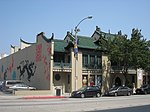Pasadena Civic Center District
Beaux-Arts architecture in CaliforniaGovernment buildings on the National Register of Historic Places in CaliforniaHistoric districts in Pasadena, CaliforniaHistoric districts on the National Register of Historic Places in CaliforniaMediterranean Revival architecture in California ... and 6 more
NRHP infobox with nocatNational Register of Historic Places in Pasadena, CaliforniaNeighborhoods in Pasadena, CaliforniaNeoclassical architecture in CaliforniaPalladian Revival architecture in CaliforniaUse mdy dates from August 2023

The Pasadena Civic Center District is the civic center of and a historic district in Pasadena, California, United States. The district is roughly bounded by Walnut and Green Streets and Raymond and Euclid Avenues.
Excerpt from the Wikipedia article Pasadena Civic Center District (License: CC BY-SA 3.0, Authors, Images).Pasadena Civic Center District
North Euclid Avenue, Pasadena
Geographical coordinates (GPS) Address Nearby Places Show on map
Geographical coordinates (GPS)
| Latitude | Longitude |
|---|---|
| N 34.14766 ° | E -118.1443 ° |
Address
Pasadena Civic Center District
North Euclid Avenue
91129 Pasadena
California, United States
Open on Google Maps






